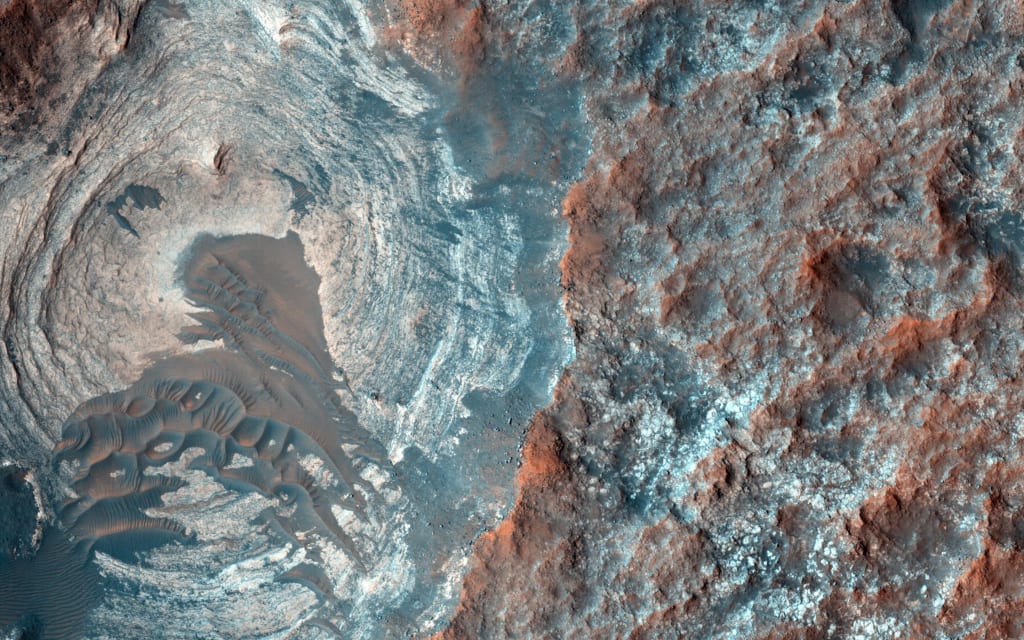Hundreds of millions of years ago, crater lakes overflowed, spilling massive floods that shaped the surface of Mars
Crater lakes flood, overflowing massive floods shape Martian surface

By reviewing a catalog of pre-existing river valleys on Mars, researchers found that crater lakes flooded hundreds of millions of years ago, and the massive flooding from crater overflows played a huge role in shaping the Martian surface.
On Mars, large-scale floods from crater lakes overflowing played a huge role in shaping the Martian surface, carving abyss and moving large amounts of sediment, according to researchers at The University of Texas at Austin, a new study shows.
That is to say, the surface of Mars was washed away by a wave of rapid and violent floods formed by the crater. They then published the study Sept. 29 in the journal Nature.
Where does the water come from?
There is clear geological evidence on the floor of the crater that it has ancient riverbeds and ponds, but there is no evidence that the water may have entered the crater from the outside, nor that groundwater may have been active from below . So where did the water come from?
Although there is no liquid water on Mars today, 4.3 billion years ago there was enough water on the red planet to cover the entire surface, forming liquid water about 450 feet (137 meters) deep, according to NASA Floor.
The researcher also said that there should have been more water in Mars' early history, but water never completely covered Mars.
But crater lakes are common on Mars when there is liquid water on the surface, and some craters can hold a small ocean of water.
But when the water becomes too much to hold, it bursts through the crater's rim, causing catastrophic flooding and forming valleys in its wake.
"Anyway, once the lake starts rushing out of the lake, it quickly carves out an outlet gap and a canyon to let more water out and continues in an uncontrolled process until it can't erode any more," Gooch said. ."
Previous research has suggested that Martian canyons may have been formed by water flowing under ice sheets that cover groundwater and the surface.
In the past, there were several craters on the surface of Mars that were filled with water, and liquid water not only stably existed, but even continued to overflow.
The deep valleys that formed on the surface of Mars billions of years ago may have influenced the formation of many other river valleys, including many lakes formed because the interior of the crater filled with water.
NASA's Mars rovers Perseverance and Curiosity also believe that Jessero and Gale Craters are filled with water.
According to Mr. Guji, there are more than 200 craters where the lake once existed, and there are still canyons carved by the flood that accompanied the lake.
research process
Satellites orbiting Mars, taking remote-sensing images that allow scientists to study the remains of a ruptured Martian crater lake.
But the study also needed to review a catalog of pre-existing river valleys on Mars and divide them into two categories.
The first is formed during the flooding of lake banks and originates in river valleys at the rim of the crater, and the second is formed elsewhere in the landscape and gradually formed over time.
The river valley is flanked by jagged rock faces like some of the most impressive modern canyons on Earth.
By comparing the depth, length and volume of different types of river valleys, scientists found that the valley formed by the rupture of the crater lake, although only 3% of the total length of the valley, weighed far more than it.
At 559 feet, the middle of the rift is more than twice as deep as other river valleys that have gradually formed over time. The average depth of Category II river valleys is about 254 feet.
Also, while the cracks appear in geological moments, they can have lasting effects on the surrounding landscape.
The researchers therefore believe that the violent flooding was either caused by water inside the deep lake of the crater beginning to overflow the rim; or when the lake filled with water, the pressure from the water inside the crater caused the rim of the crater to rupture, causing the water to flow out.
"Lake outburst flooding is a very important process on a global scale if we consider how sediment moved across the ancient Martian landscape," said Tim Gooch, assistant professor in the University of Texas' Jackson School of Earth Sciences. The results were very surprising, since they have long been considered a one-time anomaly."
The new finding may be that weeks of flooding eroded enough sediment to completely fill Lake Superior and Lake Ontario.
Much of the research on Crater Lake and its river valleys has been done on an individual basis in the past, Guji said. But this is the first study of how the 262 fractured lakes that span the Red Planet shape the entire Martian surface.
The study found
On Earth, river erosion typically occurs year after year, a very slow process that recedes coastal lands as hydraulic forces break through sediments.
But on Mars, massive floods from crater lakes have played a huge role in shaping the Martian surface, carving deep fissures and washing away vast amounts of sediment.
The study suggests that lake bank valleys play an important role in shaping the Martian surface, but Googie said it's also a lesson to look forward to.
Because these fissures washed such deep canyons, they may have influenced the formation of other nearby river valleys. But it's also a potential alternative explanation for the unique Martian valley topography often attributed to climate.
"The reason for this difference may be that the outlet canyon is much deeper than other river valleys," said study co-author Alexander Morgan, a research scientist at the Planetary Science Institute.
In most cases, Earth's geology has eliminated most of the craters and made fluvial erosion a slow and steady process. But that doesn't mean it will work this way in other worlds.
"When you fill a crater with water, there's a lot of stored energy being released there, and in that case it makes sense that Mars might be more vulnerable to a catastrophe than Earth," Googie said.
About the Creator
sayre laylah
Tired of monotonous climbing moves, but every step is close to the top
Enjoyed the story? Support the Creator.
Subscribe for free to receive all their stories in your feed. You could also pledge your support or give them a one-off tip, letting them know you appreciate their work.






Comments
There are no comments for this story
Be the first to respond and start the conversation.